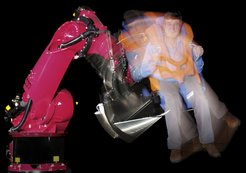“Air taxis are coming soon”
Major urban centres are being visibly choked by traffic, which is why, as early as 2025, passenger transport, particularly in megacities, could move into the third dimension with the aid of small aircraft used, for example, as air taxis. This is the conclusion reached in a study carried out by business consultants Horváth & Partners. We talked to Heinrich H. Bülthoff, retired director at the Max Planck Institute for Biological Cybernetics, about the current study, the steps that are still required for personal aviation and the findings from the myCopter project. In the course of this EU research initiative, which ran from 2011 to 2014, Bülthoff and his team studied the prospects for personal aviation.

Mr Bülthoff, how realistic do you find the prediction that small aircraft will be transporting passengers in the first major cities as early as 2025?
I find it completely realistic. Of course, it won't happen on a grand scale by then. But I think that the first field trials will certainly be underway. And it will gradually expand from there. There are currently 120 companies working in this field. Uber, for example, is extremely active in it.
Will this form of transport only be available to those, who already have themselves flown about in helicopters?
Initially, it will certainly not be the case that there’ll be air taxis for everyone as Uber imagines. In the beginning it really will be more of an option for VIPs, for example to get from an airport to the city. Fraport AG and Volocopter are already working on this in Frankfurt. We also investigated similar questions for Frankfurt. Over the long-term the cost of air taxis will then certainly sink in line with increasing production numbers, so that more people will be able to use this form of transport.
Why should passenger transport be moved into the air, at least partially?
We spend infinite sums on roadworks and roads occupy an enormous surface area. In addition, people are being stuck in tailbacks for longer and longer periods, especially in the large urban centres. That's why I’m also for putting more money into railway traffic. Air taxis are another alternative.
You yourself have been conducting research into whether and how personal aviation may be possible since the 2000s: there was even the EU myCopter project, which studied the subject between 2011 and 2014. How did people react to this?
People used to smile condescendingly when, in the early 2000s, I used to say that we might see this happening in 15 to 20 years. That was still the case as we wanted to launch a follow-up project for myCopter and I asked the major helicopter manufacturers if they were interested in collaborating. But we were still a bit ahead of ourselves at that time. Then, when the Chinese company Ehang presented its concept for individualized aircraft at the 2016 Consumer Electronics trade fair in Las Vegas, the car manufacturers also become interested.
What were your findings from the myCopter project?
We demonstrated that personal transport in the third dimension is possible. To this end, we dealt with both technical questions and issues of public acceptance. In terms of technology, for example, we looked at automation and man-machine interfaces, which we researched in collaboration with the ETH, the DLR and the University of Liverpool and which I’m still working on with my emeritus working group.
So, will the pilot’s licence replace the driving licence?
Of course, we can't turn every car driver into a helicopter pilot. But it is possible to simplify flying with the aid of automation. It currently takes our students just two hours to learn how to control and steer a helicopter. It generally takes trainee pilots ten hours just to learn to stabilize a traditional helicopter when hovering. It then takes another 40 to 50 hours to get a pilot’s licence. That is certainly too time-consuming and too expensive for training the many air taxi drivers that will be needed. It should be more straight forward with the right man-machine interfaces and automation technology.
Speaking of automation, will the aircraft even need pilots in the long-term or will they fly autonomously in the future?

That's what Uber is hoping, of course, because then they’ll no longer need taxi drivers. Although fully automatic flight is already possible, pilots will certainly be needed in the beginning, because passengers are pretty unlikely to get into an air taxi unless there's a pilot up front. But if people become more and more accepting of assistance systems in cars then there will be driverless cars at some point. And then, in the next step, we’ll see pilotless air taxis. Volocopter has already achieved fully automated flight in Dubai and is now planning tests in Singapore. In the USA too some metropolises have registered their interest in carrying out field trials of this type.
What technical improvements are still required to help establish this technology?
Because all currently planned aviation devices are powered either fully electrically or by hybrid motors, their range is very limited by the battery technology. And noise is also an issue still. Whilst multicopters, for example, are quieter than helicopters, I’m not sure if they're quiet enough. I think further technical developments are necessary to address these issues. But a lot of money is being pumped into this right now, so I’m confident that air taxis will soon be a reality.
You've already mentioned public acceptance and also addressed this aspect in the myCopter project: what were your relevant findings?
We surveyed people in Liverpool, Tübingen and Zurich about this, because we were able to use simulators there to give the people in the focus groups a feeling of what it would be like flying to work. Then we asked the participants what they thought about it. We found major differences. In Liverpool we had people who get stuck in tailbacks every morning because they have to cross a bridge. In the simulation, they were able to simply fly over the bridge, which they found really great. Many people in Zurich said: we've already got a super infrastructure here, but even that is reaching its limits. We can imagine personal aviation during the rush hour but not on weekends when we want to sit out on the balcony without having to watch something flying over it. It's also a question of privacy. To improve public acceptance in this respect it would be possible to establish flight corridors above the motorways where there's already traffic anyway.
And, how did people in Tübingen react?
Rather negatively. Many people here said that it can’t be efficient to fly through the air. But the aviation devices currently being developed are all electrically powered. Provided that the electricity comes from renewable sources then it could absolutely be efficient and sustainable. The noise was another major issue. However, even at that time we said that personal aviation devices would probably not be able to take off in the town centre. They would have to build park and fly facilities similar to today's park and ride areas. And, finally, people were worried about things falling on their heads.
Is this fear completely baseless?
It's really interesting how poorly people perceive probabilities. We accept the 3000 people killed in road traffic accidents each year. The risk of accidents is much smaller in the air than on the roads because an air taxi would be able to avoid obstacles not just be swerving round to the side but also by flying over or under them. Apart from that we can simply demand and deploy something like automatic car-to-car communications for air traffic. By contrast, there’ll be increasing numbers of cars on the roads over the coming decades, which won't have car-to-car communication systems.
What would happen if an air taxi were to break down?
Whereas it wouldn't be possible to park a personal aviation device in the event of a motor failure in the same way as a car stops at the side of the road, the latest concepts for air taxis include extreme levels of redundancy so that you could still fly to an emergency landing strip if necessary. Our partner at the EPFL Lausanne has even been researching how such landing strips could be recognised automatically.
Public acceptance will also depend on clarifying legal questions, for example in relation to insurance claims. These issues have not even been resolved in relation to driverless cars. How could one handle such matters in relation to personal aviation?
My belief is that Uber, for example, will accumulate reserves to cover insurance claims or will negotiate with insurance companies: then it will simply be paid.
Another issue that remains unclear is the question of regulation. Aviation is subject to extremely tight regulations: Aren’t these at odds with personal aviation?
We've always considered the question of regulation to be the greatest barrier. But even in this context there's a lot going on. The FAA, America's aviation authority, and the responsible authorities in Europe have recently become relatively open to new concepts. There are still regulatory issues to do with landing strips in urban areas, which is why they will probably be on the outskirts initially.













